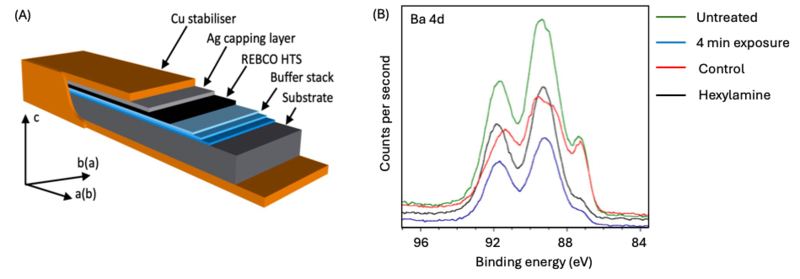REBa2Cu3O7 (REBCO) high temperature superconductors (HTS), with their ability to carry enormous resistance-free currents at relatively high temperatures and high magnetic fields, are promising materials for high field magnet applications such as nuclear magnetic resonance (NMR), magnetic resonance imaging (MRI) and fusion. REBCO is commercially manufactured in the form of multilayered flexible tape called coated conductor (Fig A). However, magnets require much longer lengths of conductor that can be manufactured in one piece, so joint technologies are needed. For NMR and MRI applications, these joints need to be truly superconducting, with resistance values < 10-12 ohms, because they need to operate in persistent current mode without a power supply. There is currently no manufacturing technique for making NMR quality joints on the factory floor.
Our aim is to develop a new low temperature jointing process by exposing the REBCO layer of coated conductor and assembling the joint with the two exposed faces in contact with each other. However, the surfaces of REBCO compounds are not very stable, readily degrading in contact with moist air (for example). The presence of a degraded surface layer, although not affecting current transport along the tape, will seriously affect joint properties as supercurrent will need to pass through the damaged layer. Since the coherence length of REBCO is short (~1 nm), only a sub-nanometre non-superconducting barrier can be tolerated without loss of performance.

(A) Schematic of coated conductor. (B) XPS results showing effects of different surface treatments.
Following early research in the late 1990s into surface modification of REBCO using alkylamine treatments to form self-assembled monolayers (SAM) with the aim of enabling improved multilayer deposition for thin film device applications [1,2], we have recently performed some preliminary trials on REBCO coated conductor with promising initial results. The aim of this project is to investigate whether this approach can be successfully developed to produce “cleaner” REBCO surfaces that will remain stable under ambient conditions for long enough for joints to be manufactured. It will involve using a range of surface characterisation spectroscopy, microscopy and electrochemical techniques to deduce the mechanism for SAM formation. This is important because there are currently two different hypotheses for the SAM formation mechanism, one proposing that the alkylamine etches away the degraded REBCO layer before being adsorbed onto the pristine REBCO surface, whereas the other does not involve the removal of any pre-existing degraded REBCO layer. Armed with an improved understanding of the SAM formation mechanism, a suitable coated conductor surface preparation process will be developed for joint manufacture. We will also assess whether this treatment can be adapted for HTS quantum device manufacture where lossy surfaces can limit performance [3].
[1] Ritchie et al, J. Am. Chem. Soc. 1999, 121, 7447-7448; [2] Xu et al, Langmuir 2000, 16, 2169-2176; [3] Fogaly et al, Rev. Sci. Inst. 2006, 77, 101101